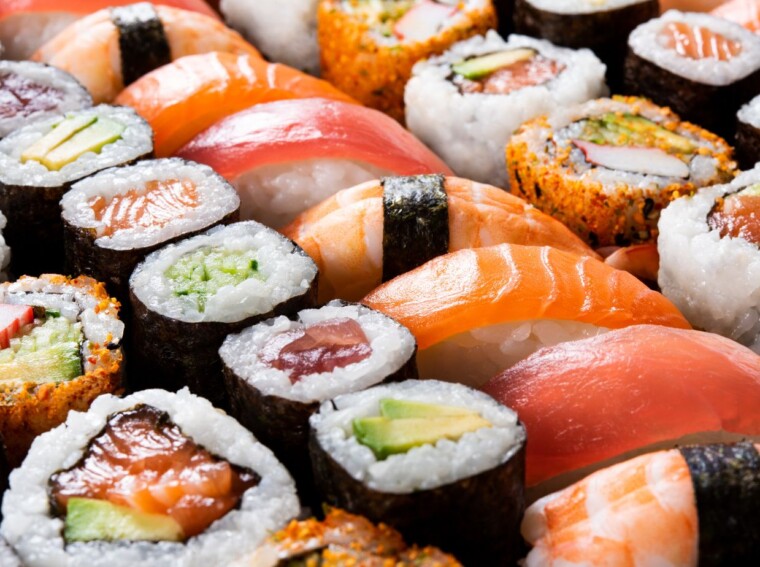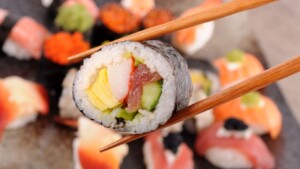 When referring to raw fish used in sushi preparation, it is commonly known as ikan mentah yang dijadikan bahan masakan sushi dinamakan. Sushi enthusiasts often seek the freshest and highest quality raw fish for their favorite rolls and sashimi dishes. Understanding the significance of this specific term adds depth to one’s appreciation of sushi culture and culinary traditions. The term encapsulates the essence of using raw fish as a central ingredient in creating these beloved Japanese delicacies.
When referring to raw fish used in sushi preparation, it is commonly known as ikan mentah yang dijadikan bahan masakan sushi dinamakan. Sushi enthusiasts often seek the freshest and highest quality raw fish for their favorite rolls and sashimi dishes. Understanding the significance of this specific term adds depth to one’s appreciation of sushi culture and culinary traditions. The term encapsulates the essence of using raw fish as a central ingredient in creating these beloved Japanese delicacies.
Ikan Mentah Yang Dijadikan Bahan Masakan Sushi Dinamakan
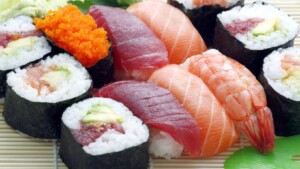 When it comes to sushi, the type of raw fish used plays a crucial role in determining the flavor and quality of this beloved Japanese dish. In Japanese culinary tradition, raw fish destined for sushi is referred to as ikan mentah yang dijadikan bahan masakan sushi dinamakan. This term encapsulates the essence of using fresh, high-quality fish as a key ingredient in creating delectable sushi offerings.The selection of ikan mentah yang dijadikan bahan masakan sushi dinamakan varies depending on factors such as seasonality, regional preferences, and personal taste. Popular choices include tuna (maguro), salmon (sake), yellowtail (hamachi), and mackerel (saba). Each type of fish brings its unique texture, flavor profile, and nutritional benefits to the table, contributing to the diverse tapestry of flavors found in sushi cuisine.In addition to traditional favorites like tuna and salmon, modern variations of sushi have expanded the repertoire of ikan mentah yang dijadikan bahan masakan sushi dinamakan. Creative combinations featuring seafood such as octopus (tako), sea urchin (uni), eel (unagi), and shrimp (ebi) showcase the versatility and innovation within the realm of sushi preparation. These ingredients add depth and complexity to sushi rolls, sashimi plates, and nigiri presentations.The artistry involved in sourcing, handling, and preparing ikan mentah yang dijadikan bahan masakan sushi dinamakan reflects a deep respect for culinary craftsmanship and attention to detail. Sushi chefs undergo rigorous training to master techniques that highlight the natural flavors of raw fish while ensuring food safety standards are met. By honoring the tradition of using premium raw fish in sushi making, chefs uphold a legacy of excellence that continues to captivate palates worldwide.
When it comes to sushi, the type of raw fish used plays a crucial role in determining the flavor and quality of this beloved Japanese dish. In Japanese culinary tradition, raw fish destined for sushi is referred to as ikan mentah yang dijadikan bahan masakan sushi dinamakan. This term encapsulates the essence of using fresh, high-quality fish as a key ingredient in creating delectable sushi offerings.The selection of ikan mentah yang dijadikan bahan masakan sushi dinamakan varies depending on factors such as seasonality, regional preferences, and personal taste. Popular choices include tuna (maguro), salmon (sake), yellowtail (hamachi), and mackerel (saba). Each type of fish brings its unique texture, flavor profile, and nutritional benefits to the table, contributing to the diverse tapestry of flavors found in sushi cuisine.In addition to traditional favorites like tuna and salmon, modern variations of sushi have expanded the repertoire of ikan mentah yang dijadikan bahan masakan sushi dinamakan. Creative combinations featuring seafood such as octopus (tako), sea urchin (uni), eel (unagi), and shrimp (ebi) showcase the versatility and innovation within the realm of sushi preparation. These ingredients add depth and complexity to sushi rolls, sashimi plates, and nigiri presentations.The artistry involved in sourcing, handling, and preparing ikan mentah yang dijadikan bahan masakan sushi dinamakan reflects a deep respect for culinary craftsmanship and attention to detail. Sushi chefs undergo rigorous training to master techniques that highlight the natural flavors of raw fish while ensuring food safety standards are met. By honoring the tradition of using premium raw fish in sushi making, chefs uphold a legacy of excellence that continues to captivate palates worldwide.
Types of Raw Fish Used for Sushi
Tuna
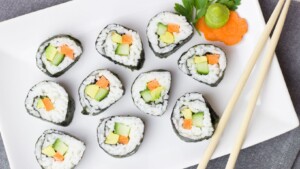 Tuna is a staple in sushi preparation due to its rich flavor and firm texture. Varieties like maguro and otoro are popular choices among sushi enthusiasts for their distinct taste profiles. The deep red color of fresh tuna slices adds visual appeal to sushi platters, making them enticing even before the first bite. Whether enjoyed as nigiri, sashimi, or in rolls like spicy tuna, this versatile fish elevates the sushi experience.
Tuna is a staple in sushi preparation due to its rich flavor and firm texture. Varieties like maguro and otoro are popular choices among sushi enthusiasts for their distinct taste profiles. The deep red color of fresh tuna slices adds visual appeal to sushi platters, making them enticing even before the first bite. Whether enjoyed as nigiri, sashimi, or in rolls like spicy tuna, this versatile fish elevates the sushi experience.
Salmon
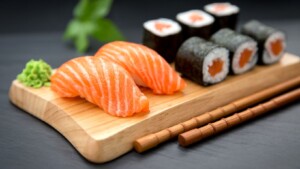 Salmon is another prized ingredient in sushi-making, renowned for its buttery texture and delicate taste. Sake, as it’s known in Japanese cuisine, offers a milder flavor compared to other raw fish options, making it an ideal choice for those new to sushi. From classic salmon nigiri to creative rolls incorporating avocado and cream cheese, the versatility of salmon allows chefs to experiment with various flavor combinations that cater to diverse palates.
Salmon is another prized ingredient in sushi-making, renowned for its buttery texture and delicate taste. Sake, as it’s known in Japanese cuisine, offers a milder flavor compared to other raw fish options, making it an ideal choice for those new to sushi. From classic salmon nigiri to creative rolls incorporating avocado and cream cheese, the versatility of salmon allows chefs to experiment with various flavor combinations that cater to diverse palates.
Yellowtail
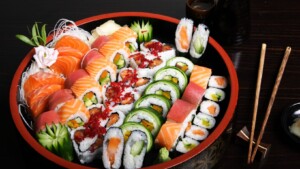 Yellowtail, or hamachi, is favored for its slightly sweet taste and velvety texture that melts in your mouth. This fish adds a touch of luxury to any sushi dish with its distinctive flavor profile. Whether served as sashimi with a hint of soy sauce and wasabi or featured in specialty rolls alongside ingredients like jalapeño and citrus-infused sauces, yellowtail brings a unique flair to traditional and contemporary sushi creations.The art of preparing sushi extends beyond skillful knife work; it encompasses a deep respect for ingredients like ikan mentah yang dijadikan bahan masakan sushi dinamakan (raw fish used for making sushi). With each slice of tuna, salmon fillet, or yellowtail portion carefully selected and expertly presented on seasoned rice by skilled chefs worldwide, every bite becomes an exquisite culinary experience that celebrates the natural flavors of these premium seafood selections.
Yellowtail, or hamachi, is favored for its slightly sweet taste and velvety texture that melts in your mouth. This fish adds a touch of luxury to any sushi dish with its distinctive flavor profile. Whether served as sashimi with a hint of soy sauce and wasabi or featured in specialty rolls alongside ingredients like jalapeño and citrus-infused sauces, yellowtail brings a unique flair to traditional and contemporary sushi creations.The art of preparing sushi extends beyond skillful knife work; it encompasses a deep respect for ingredients like ikan mentah yang dijadikan bahan masakan sushi dinamakan (raw fish used for making sushi). With each slice of tuna, salmon fillet, or yellowtail portion carefully selected and expertly presented on seasoned rice by skilled chefs worldwide, every bite becomes an exquisite culinary experience that celebrates the natural flavors of these premium seafood selections.
Sushi Preparation Techniques
Sashimi
 When it comes to sushi preparation techniques, Sashimi stands out as a traditional and revered method. This style focuses on thinly sliced raw fish or seafood served without rice. The key lies in the quality of the ikan mentah yang dijadikan bahan masakan sushi dinamakan, with freshness being paramount. Chefs meticulously slice the fish to highlight its texture and flavor, often presenting it artfully on a plate. Common types of sashimi include tuna (maguro), salmon (sake), and yellowtail (hamachi).
When it comes to sushi preparation techniques, Sashimi stands out as a traditional and revered method. This style focuses on thinly sliced raw fish or seafood served without rice. The key lies in the quality of the ikan mentah yang dijadikan bahan masakan sushi dinamakan, with freshness being paramount. Chefs meticulously slice the fish to highlight its texture and flavor, often presenting it artfully on a plate. Common types of sashimi include tuna (maguro), salmon (sake), and yellowtail (hamachi).
Nigiri
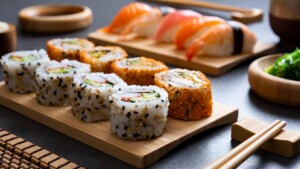 Nigiri showcases simplicity at its finest in sushi creation. It consists of hand-pressed vinegared rice topped with a slice of fresh raw fish or seafood, sometimes bound together with a thin strip of nori seaweed. The delicate balance between the rice’s seasoning and the topping’s freshness is crucial for an exceptional nigiri experience. Varieties like tuna (maguro), shrimp (ebi), and squid (ika) are popular choices for nigiri enthusiasts.
Nigiri showcases simplicity at its finest in sushi creation. It consists of hand-pressed vinegared rice topped with a slice of fresh raw fish or seafood, sometimes bound together with a thin strip of nori seaweed. The delicate balance between the rice’s seasoning and the topping’s freshness is crucial for an exceptional nigiri experience. Varieties like tuna (maguro), shrimp (ebi), and squid (ika) are popular choices for nigiri enthusiasts.
Maki
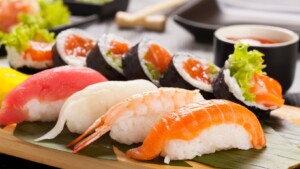 Maki, known for its roll form, offers a delightful fusion of flavors and textures in each bite. This technique involves wrapping ingredients such as fish, vegetables, and rice inside nori seaweed before rolling them tightly together using a bamboo mat. Maki rolls come in various types like California roll, spicy tuna roll, and cucumber avocado roll, catering to diverse palates seeking innovative sushi combinations.In mastering Sushi Preparation Techniques, chefs not only hone their culinary skills but also pay homage to centuries-old traditions that celebrate the essence of Japanese cuisine. Each technique requires precision, finesse, and an appreciation for sourcing high-quality ingredients such as the revered ikan mentah yang dijadikan bahan masakan sushi dinamakan. Whether indulging in sashimi’s purity, nigiri’s elegance, or maki’s creativity, sushi enthusiasts embark on a gastronomic journey filled with sophistication and artistry.
Maki, known for its roll form, offers a delightful fusion of flavors and textures in each bite. This technique involves wrapping ingredients such as fish, vegetables, and rice inside nori seaweed before rolling them tightly together using a bamboo mat. Maki rolls come in various types like California roll, spicy tuna roll, and cucumber avocado roll, catering to diverse palates seeking innovative sushi combinations.In mastering Sushi Preparation Techniques, chefs not only hone their culinary skills but also pay homage to centuries-old traditions that celebrate the essence of Japanese cuisine. Each technique requires precision, finesse, and an appreciation for sourcing high-quality ingredients such as the revered ikan mentah yang dijadikan bahan masakan sushi dinamakan. Whether indulging in sashimi’s purity, nigiri’s elegance, or maki’s creativity, sushi enthusiasts embark on a gastronomic journey filled with sophistication and artistry.

